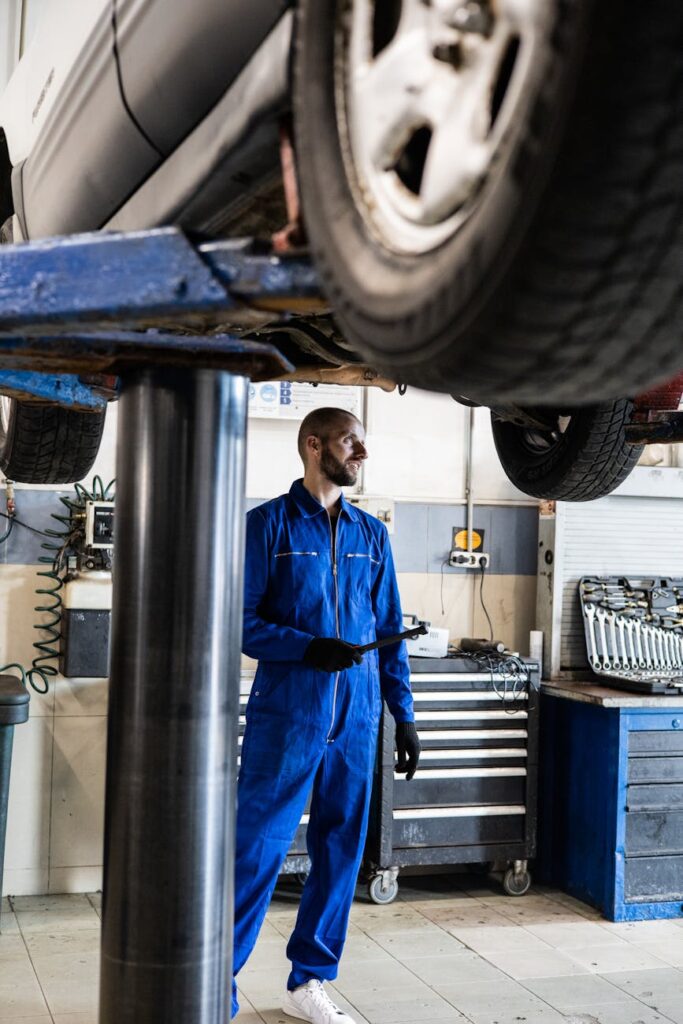The End of Traffic Jams? How AI is Quietly Remapping Our World
Remember the last time you were stuck in bumper-to-bumper traffic? That slow, grinding frustration. You probably stared at the endless sea of red taillights and thought, “There has to be a better way.” Well, there is. It’s not about flying cars (not yet, anyway). It’s about intelligence. The profound impact of AI in transportation is no longer a sci-fi dream; it’s a rapidly unfolding reality that’s fundamentally changing how we move ourselves, our packages, and our entire economy from point A to point B. This isn’t just about a car that parks itself. We’re talking about a complete overhaul of a system that’s been running on the same basic principles for over a century. It’s about making our journeys faster, our roads safer, and our cities smarter. And it’s happening right now.
Key Takeaways
- More Than Self-Driving Cars: AI’s influence extends far beyond autonomous vehicles, optimizing traffic flow, public transit, and complex logistics networks.
- Safety is the Primary Driver: A huge motivation for AI in transport is its potential to drastically reduce human error, which is the cause of over 90% of traffic accidents.
- Efficiency is a Game-Changer: From fuel consumption to delivery times, AI is streamlining operations, saving billions of dollars and reducing environmental impact.
- Major Hurdles Remain: Despite rapid progress, significant ethical, regulatory, and technological challenges must be overcome before we see full-scale adoption.
What’s Actually Under the Hood? The Tech Driving the Change
When we say “AI,” it sounds like a single, magical thing. But it’s not. It’s a collection of powerful technologies working in concert. Think of it less like a single genius and more like a team of highly specialized experts. In transportation, a few key players are doing the heavy lifting.
Machine Learning: The Brains of the Operation
At its core, Machine Learning (ML) is what allows a system to learn from data without being explicitly programmed. It’s the digital equivalent of experience. A self-driving car’s computer doesn’t have a line of code for every single possible event on the road—that would be impossible. Instead, it’s been ‘trained’ on millions of miles of driving data, both real and simulated. It has seen countless examples of pedestrians, cyclists, sudden stops, and confusing intersections. Through this training, it learns to identify patterns, predict behaviors, and make split-second decisions. It learns what a stop sign looks like from different angles, in different weather, even when partially obscured. This ability to learn and adapt is the absolute cornerstone of modern AI.
Computer Vision: The Eyes on the Road
How does the car get all that data in the first place? Through an array of sensors, but most importantly, through computer vision. This is the technology that allows machines to ‘see’ and interpret the world. Cameras, LiDAR (Light Detection and Ranging), and radar act as the eyes, constantly scanning the environment. But just capturing images isn’t enough. Computer vision algorithms are what process that firehose of visual information, identifying and classifying objects in real-time. That’s not just a shape, it’s a pedestrian. That’s not just a box, it’s a delivery truck changing lanes. It can track the trajectory of a bouncing ball rolling into the street and predict that a child might follow it. This superhuman level of perception is critical for navigating a chaotic and unpredictable world.

Natural Language Processing: The Art of Conversation
AI’s role isn’t just about driving. It’s also about interaction. Natural Language Processing (NLP) is the branch of AI that helps computers understand and respond to human language. Think about your in-car voice assistant. When you say, “Hey car, find the nearest coffee shop with good reviews,” NLP is what parses your sentence, understands your intent, and executes the command. In public transit, it powers real-time information bots that can answer questions about delays or route changes. For logistics companies, it can analyze driver reports or customer feedback to identify systemic issues. It bridges the gap between human communication and machine execution.
The Revolution on Our Roads: Autonomous Vehicles
Let’s be honest, this is the part that captures everyone’s imagination. The idea of sitting back, reading a book, or taking a nap while your car handles the morning commute is incredibly appealing. But the journey to a fully autonomous future is a series of steps, not a single leap.
More Than Just ‘On’ or ‘Off’: The Levels of Autonomy
Autonomy isn’t a binary switch. The Society of Automotive Engineers (SAE) has defined six levels, from 0 to 5, to classify a vehicle’s capabilities:
- Level 0: No automation. You, the human, do everything. This is your classic car.
- Level 1: Driver Assistance. The car can help with one thing at a time, like adaptive cruise control that maintains a set distance from the car in front.
- Level 2: Partial Automation. The car can control both steering and speed simultaneously under certain conditions, like Tesla’s Autopilot or GM’s Super Cruise. Crucially, the driver must remain fully engaged and ready to take over at any moment. This is the highest level widely available in consumer cars today.
- Level 3: Conditional Automation. The car can manage most aspects of driving in specific environments (like a highway), allowing the driver to disengage. However, it will alert the driver when they need to take back control, and they must be ready to do so. This is a tricky legal and technical gray area.
- Level 4: High Automation. The car can handle all driving tasks within a specific, geofenced area or set of conditions (e.g., a downtown robotaxi service). It won’t operate outside that defined zone, but within it, it needs no human intervention.
- Level 5: Full Automation. The holy grail. The car can operate on any road, under any conditions, that a human driver could. There might not even be a steering wheel or pedals.
Understanding these levels is key. We’re much closer to Level 4 in limited applications than we are to Level 5 being a common sight on every street corner.
The Hurdles We Still Face
So, why aren’t our cities buzzing with Level 5 vehicles yet? The challenges are immense. First, there’s the technology itself. While AI is incredible, it struggles with ‘edge cases’—rare and unpredictable events that human drivers often handle intuitively. A construction worker waving traffic through with hand signals, a flock of geese crossing the road, or a bizarre reflection tricking the sensors. Perfecting the system to handle the near-infinite variety of real-world chaos is a monumental task. Then comes the legal and regulatory maze. Who is at fault in an accident involving an autonomous car? The owner? The manufacturer? The software developer? Our laws were written for human drivers, and the framework for AI is still being built. Finally, there are the ethical dilemmas. The infamous ‘trolley problem’ gets a modern update: if a crash is unavoidable, does the car swerve to hit one person to save five? Who makes that decision, and what values are programmed into the machine? These are not just technical problems; they are deeply human ones we must solve.
Beyond the Car: How AI in Transportation is Reshaping Everything Else
The spotlight may be on self-driving cars, but the most significant changes are happening behind the scenes, across the entire transportation ecosystem.
Smart Traffic Management
Gridlock costs economies billions of dollars in lost productivity and wasted fuel. AI offers a way out. Instead of fixed-timer traffic lights, imagine a network of intelligent signals that react to real-time traffic flow. AI systems can analyze data from road sensors, GPS devices, and cameras to understand traffic patterns as they emerge. Is there a concert letting out? A fender-bender on the freeway? The system can dynamically adjust light timings, reroute traffic through navigation apps, and even change speed limits to prevent congestion before it starts. This creates a ‘smart grid’ for our roads, making the entire system more fluid and efficient for everyone, not just those in fancy cars.

Public Transit Gets an Upgrade
For decades, public transit has often been plagued by inefficiency and unreliability. AI is changing that. Predictive algorithms can analyze ridership data, weather patterns, and local events to optimize bus and train schedules in real time. Instead of ghost buses running empty on a Tuesday afternoon, resources can be dynamically allocated to where the demand is. On-demand micro-transit services, like smart shuttles summoned via an app, can fill the gaps in traditional fixed-route systems, providing better service to underserved areas. For passengers, AI-powered apps provide hyper-accurate arrival times and seamless multimodal trip planning, making public transit a more attractive and viable option.
Revolutionizing Logistics and Supply Chains
The journey of a simple package you order online is mind-bogglingly complex. AI is the secret sauce that makes modern e-commerce possible. It starts in the warehouse, where robots navigate aisles to pick and pack orders with incredible speed. From there, AI algorithms plot the most efficient delivery routes for trucks, factoring in traffic, weather, delivery windows, and fuel costs. This is the ‘traveling salesman problem’ on a planetary scale, and AI is exceptionally good at solving it. Companies are also using AI for predictive maintenance, analyzing sensor data from their vehicle fleets to predict when a part is likely to fail. This allows them to perform repairs proactively, preventing costly breakdowns and delays that can ripple through the entire supply chain.
The Big Picture: Benefits and Challenges
This technological wave brings with it a tide of profound societal change, creating both incredible opportunities and significant challenges we need to address head-on.
The Upside: Safety, Efficiency, and Accessibility
The potential benefits are enormous. The single greatest promise is safety. Over 1.3 million people die in road accidents globally each year, and over 90% of those are caused by human error. AI drivers don’t get tired, drunk, or distracted. Even at current levels, driver-assist features are already preventing accidents. The efficiency gains in logistics and traffic management will lead to lower fuel consumption, reducing both costs and carbon emissions. And perhaps most importantly, AI promises a new level of accessibility. For the elderly and people with disabilities, autonomous vehicles could provide unprecedented freedom and independence, connecting them to their communities in ways that were previously impossible.
The Downside: Job Displacement and Data Privacy
Of course, this transformation isn’t without its concerns. The most immediate is job displacement. Millions of people work as truck drivers, taxi drivers, and delivery drivers. While AI will create new jobs in tech, maintenance, and system management, it will undoubtedly disrupt these established professions, requiring a societal plan for retraining and transition. Then there’s the issue of data. To function, these smart systems need to collect a staggering amount of information about where we go, when we go there, and how we travel. Who owns this data? How is it used? How is it protected from hackers? Ensuring robust privacy and security protocols is not just a technical challenge; it’s a fundamental requirement for public trust.
Conclusion
The integration of AI in transportation is not a distant future. It is the engine of change, humming beneath the surface of our daily lives, getting louder and more powerful every year. It’s a complex, messy, and thrilling revolution. We’re moving from a system of isolated, human-operated machines to a connected, intelligent, and responsive network. The road ahead will have its bumps, detours, and debates. But one thing is clear: the way we move is about to be completely redrawn, and our world will be transformed along with it. The age of intelligent transportation has arrived, and it’s taking us all for a ride.
FAQ
-
Will AI completely replace all human drivers?
-
Not anytime soon, and perhaps never completely. While AI will handle the vast majority of routine driving tasks, especially in commercial trucking and robotaxi services, there will likely always be a need or desire for human drivers in certain situations. This could include complex off-road environments, emergency situations, or simply recreational driving. The transition will be gradual, with humans and AI sharing the road for decades to come.
-
How secure are AI transportation systems from hacking?
-
This is one of the most critical challenges facing the industry. A hacked vehicle or traffic management system could have catastrophic consequences. As a result, cybersecurity is a top priority for developers. They employ multiple layers of security, including encrypted communications, secure hardware, and continuous monitoring for threats. It’s an ongoing arms race between security experts and malicious actors, and it requires constant vigilance and innovation to keep the systems safe.
-
Isn’t this technology incredibly expensive?
-
Initially, yes. The sensors, computing power, and research required for autonomous systems are costly, which is why they often appear on luxury vehicles first. However, like all technology, the costs are decreasing rapidly as manufacturing scales up and the technology matures. For commercial applications like trucking and logistics, the high upfront cost is often quickly offset by massive savings in fuel, labor, and efficiency, creating a strong business case for adoption.



 AI and Big Data: The Ultimate Power Couple Explained
AI and Big Data: The Ultimate Power Couple Explained  Build AI-Powered Apps: Your Ultimate 2024 Starter Guide
Build AI-Powered Apps: Your Ultimate 2024 Starter Guide  Deep Learning Breakthroughs: The AI Revolution Explained
Deep Learning Breakthroughs: The AI Revolution Explained  How AI is Revolutionizing Modern Agriculture
How AI is Revolutionizing Modern Agriculture  Top Natural Language Processing Applications Explained
Top Natural Language Processing Applications Explained  How AI for E-commerce is Changing Online Retail in 2024
How AI for E-commerce is Changing Online Retail in 2024  AI and Blockchain: A Powerful Tech Synergy
AI and Blockchain: A Powerful Tech Synergy  Get a Job in Blockchain: Your 2024 Web3 Career Guide
Get a Job in Blockchain: Your 2024 Web3 Career Guide  Wallet Types Explained: Hot vs Cold & More (2024 Guide)
Wallet Types Explained: Hot vs Cold & More (2024 Guide)  How Venture Capital is Shaping the Crypto Industry
How Venture Capital is Shaping the Crypto Industry  Sentiment Analysis for Crypto: A Trader’s Ultimate Guide
Sentiment Analysis for Crypto: A Trader’s Ultimate Guide  NFTs: The New Key to Membership & Brand Loyalty | Guide
NFTs: The New Key to Membership & Brand Loyalty | Guide